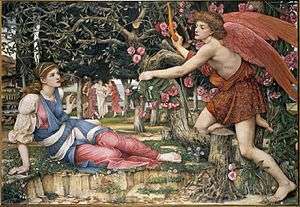Love and the Maiden
 | |
| Artist | John Roddam Spencer Stanhope |
|---|---|
| Year | 1877 |
| Type | Tempera, gold paint and gold leaf on canvas |
| Dimensions | 86.4 cm × 50.8 cm (34.0 in × 20.0 in) |
| Location | Fine Arts Museums of San Francisco, San Francisco, CA |
Love and the Maiden is a tempera on canvas by English Pre-Raphaelite artist John Roddam Spencer Stanhope, executed in 1877 and currently housed at the Fine Arts Museums of San Francisco.[1]
History
Known as one of the "second-generation" of Pre-Raphaelites, Stanhope was among Dante Gabriel Rossetti's mural-painting party at the Oxford Union in 1857, together with Arthur Hughes, John Hungerford Pollen, Valentine Prinsep, Ned Burne-Jones and William Morris (nicknamed Topsy). He was a founder member of the Hogarth Club, a direct descendant of the Pre-Raphaelite Brotherhood.[2]
This painting is considered one of Stanhope's best, and represents two radically different artistic phases of his life. Although he began as fervently Pre-Raphaelite in outlook, Stanhope was deeply attracted by the Aesthetic movement during the 1860s. Love and the Maiden is a succinct mingling of these two equally formative phases in his career. Its presence in the 1877 exhibition at the Grosvenor Gallery - Aestheticism's most famous exposé - demonstrates his adherence to the latter movement, whereas the painting's similarity to the work of Edward Burne-Jones and Dante Gabriel Rossetti - the group of dancing women in the background are similar to those portrayed by Rossetti in The Bower Meadow (1871–72) - betray Stanhope's Pre-Raphaelite background.
During his time in Oxford in 1857, Stanhope wrote that he spent most days painting with Burne-Jones;[3] possibly as a result of this, a great deal of Burne-Jones' influence can be seen in his work - although it could be argued that Burne-Jones also drew ideas from Stanhope's work. The androgynous physiques, Grecian-style draperies and facial expressions depicted in Love and the Maiden are classic Burne-Jones hallmarks, even though the facial similarities probably also arose from use of the same models.[4]
See also
References
- ↑ See Art sales: Stanhope's maiden tells a tale, article on The Telegraph, 27 January 2003.
- ↑ A.M.W. Stirling, "The Life of Roddam Spencer Stanhope, Pre-Raphaelite, a Painter of Dreams," in A Painter of Dreams and Other Biographical Studies (London: Lane, 1916).
- ↑ Jane A. Munro, "'This Hateful Letter-Writing': Selected Correspondence of Sir Edward Burne-Jones in the Huntington Library", Huntington Library Quarterly 55 (1992). Cf. also V. Schuster, "The Pre-Raphaelites in Oxford," Oxford Art Journal 1 (1978).
- ↑ T. Hilto, The Pre-Raphelites, Thames and Hudson (1970).
Further reading
- Hilto, Timoth, The Pre-Raphelites, Thames and Hudson (1970).
- Robinson, Michael, The Pre-Raphaelites, Flame Tree Publishing (2007).
- Todd, Pamela, Pre-Raphaelites at Home, Watson-Giptill Publications, (2001).
External links
| Wikimedia Commons has media related to John Roddam Spencer Stanhope. |
- Art sales: Stanhope's maiden tells a tale article on The Telegraph, 27 January 2003
- John Roddam Spencer Stanhope, artist (Victorian Art in Britain)
- Love and the Maiden on victorianweb.org
- John Roddam Spencer Stanhope by Lewis Carroll (National Portrait Gallery)